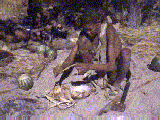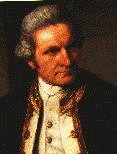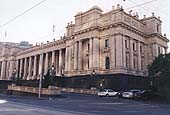|
|
 |
The first human inhabitants of Australia
were the Aborigines.
They are a dark-skinned people belonging
to the Australoid group who probably came from Asia. Nobody
is quite sure how they came to Australia around 60,000 years
ago. They may have walked and sailed here from Asia.
The Aborigines were nomadic
hunter-gathers. They roamed from place to place. They hunted
animals using spears and boomerangs. They also gathered
fruits, nuts and yams which they ate.
|
|
Australia was first visited by Europeans in the
17th century. but attracted little interest until in 1970 when
Captain James Cook, sailed into Botany Bay, [Sydney, New South
Wales] and claimed the entire eastern coast for Great Britain. |
 |
The first settlement, a penal colony for
“transported” British convicts, was established in 1788 where
Sydney now stands. By the middle of the 19th cent. free colonization
had replaced the old penal settlements, and the colonies of Tasmania
(1825), Western Australia (1829), South Australia (1834), Victoria
(1851), and Queensland (1859) had been established.

The
discovery of gold initially at Bathurst in New South Wales
and soon after at Ballarat and Bendigo in Victoria in 1851.
course brought the predictable rush of immigrants in the
hope of a lucky strike, many of these immigrants had come
from a similar Gold Rush in the Californian gold fields and
many Chinese some of whom sought the riches of the gold
themselves but many others sought business opportunities to
service the huge population on the fields. |
With a population of 4 million, the colonies were federated as states of
the Commonwealth of Australia which took place in Sydney’s
Centennial Park on the 1st January 1901.
 |
The first election for Federal Parliament was
held at the end of March 1901, and the returned members sat
for the first time on 9 May in the Exhibition Building,
Melbourne (where Federal Parliament continued to meet until
the opening of the first Parliament House in Canberra in
1927). Edmund Barton was the first Prime Minister. |
Australia fought on the side of Britain in both
world wars. In World War II the Japanese bombed or shelled Darwin,
Port Jackson, and Newcastle, and the allied victory in the battle of
the Coral Sea in 1942 probably averted an invasion of Australia.
Australia joined regional defence pacts after the war and sent
troops to aid the U.S. in the Vietnam War.
Go
To Australian History Date Line
|